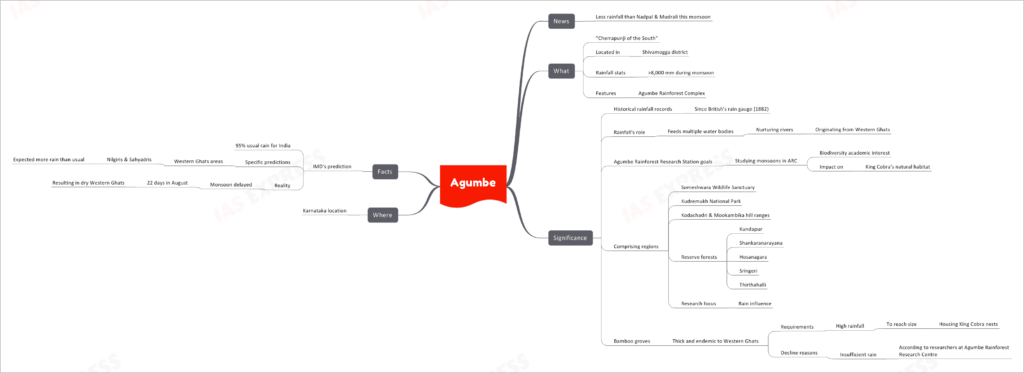Agumbe

Agumbe received lesser rainfall than Nadpal and Mudrali this monsoon
What
“Cherrapunji of the South”
- Agumbe, often dubbed as the “Cherrapunji of the South,” is known for its extraordinary rainfall.
Location
- Located in the Shivamogga district of Karnataka.
Rainfall Stats
- Agumbe receives an astonishing amount of rainfall, exceeding 8,000 mm during the monsoon season.
Features
- The Agumbe Rainforest Complex is a prominent natural feature in this region.
Significance
Historical Rainfall Records
- The area has a long history of recording rainfall data, dating back to the British era with the installation of a rain gauge in 1882.
Rainfall’s Role
- Agumbe’s heavy rainfall plays a vital role in sustaining multiple water bodies, nurturing rivers that originate from the Western Ghats.
Agumbe Rainforest Research Station Goals
- The Agumbe Rainforest Research Station is dedicated to studying monsoons in the Agumbe Rainforest Complex.
- It serves academic interests in biodiversity and investigates the impact of monsoons on the natural habitat of the King Cobra.
Comprising Regions
- The Agumbe Rainforest Complex encompasses several regions, including the Someshwara Wildlife Sanctuary, Kudremukh National Park, Kodachadri & Mookambika hill ranges, and various reserve forests such as Kundapur, Shankaranarayana, Hosanagara, Sringeri, and Thirthahalli.
- Research in these areas primarily focuses on understanding the influence of rain.
Bamboo Groves
- The region is known for its thick and endemic bamboo groves, which are vital for the Western Ghats ecosystem.
- These bamboo groves require high rainfall to reach the size needed to house King Cobra nests.
Decline in Bamboo Groves
- Researchers at the Agumbe Rainforest Research Centre have noted a decline in bamboo groves due to insufficient rain.
Where
Karnataka Location
- Agumbe is situated in the state of Karnataka.
Facts
IMD’s Prediction
- The Indian Meteorological Department (IMD) predicted 95% of the usual rainfall for India during the monsoon season.
- Specific predictions indicated that Western Ghats areas, including the Nilgiris and Sahyadris, were expected to receive more rain than usual.
Monsoon Delay
- However, the monsoon was delayed, with a 22-day delay in August.
- This delay resulted in drier conditions in the Western Ghats, affecting regions like Agumbe known for their heavy rainfall.
If you like this post, please share your feedback in the comments section below so that we will upload more posts like this.

